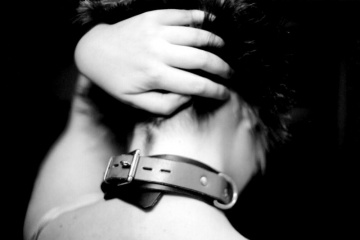 |
Peter Masters |
Peter Masters |
|
|
|||||
| About me | About this site | My books | |||||||
Collars
| Penetration |
| Engagement |
| Consent |
| Communication |
| Power |
| Authority |
| Control |
| Trust |
| Fetish |
| Defence mechanisms |
| Mapping motivations to activities |
Collars can be either:
- symbols of ownership,
- practical accessories in activities such as bondage, or
- tools in a D&s engagement.
They may be a leather strap fastened with buckle, a stainless steel band fastened with a clasp or padlock, or a simple chain, also fastened with a padlock.
Contents
Ownership
Particularly in dominant/submissive relationships a collar can serve a similar purpose to a wedding ring in a traditional marriage. The submissive will wear the collar, and it clearly advertises to other dominants that the submissive is "taken", even if just for the duration of a scene at a play party. Even when a submissive is not involved in any particular ongoing relationship with a dominant or master, they may wear a collar to signal that they are submissive, or just to keep unwanted attention away.

Rear view of collar

Girl in dungeon wearing a collar
© Raimond Spekking / Wikimedia Commons / CC-BY-SA-3.0 & GFDL

Girl wearing blindfold and collar

Girl wearing collar on a leash
Symbolism
In this use, part of the symbolism no doubt comes from the collar's historical use on actual slaves, and also as a device for restraining prisoners.
Both leather and metal collars can have padlocks which prevent their removal, and where this is the case the holder of the key will be the dominant.
Collars are frequently equipped with one or more "D"-rings and these can be, and are, used to attach a leash (in the manner of a dog's leash) to allow the dominant to lead his submissive.
Bondage
In some forms of rope bondage, the "D"-rings on a collar can serve as useful anchor points. Part of the benefit here is that a collar can distribute the pressure which must otherwise be borne by the bottom's or submissive's bare neck.
Dominance and submission
In more long-term relationship---both dominant/submissive and master/slave---a collar becomes part of the context in which the relationship evolves and exists. Placing a collar on a submissive or slave is then a formal act of claiming the submissive/slave and, eventually, there must be a corresponding act of releasing the submissive/slave when the relationship ends.
The collar thus gains more significance and is not readily removed because to do so would represent the end of the relationship. For this reason, in long-term relationships there are commonly a range of collars used. While the "symbolic" collar is never removed, the actual physical collar worn to represent it can take different forms:
- Everyday collar: an everyday collar is usually a collar of a simple design which can be worn around the house, or to casual BDSM events.
- Dress collar: a dress collar is usually more decorated, and is worn on more formal occasions. The initial act of claiming may be done with a dress collar.
- Play collar: during physical BDSM activities, such as bondage, flogging, etc., a more robust collar may be worn. This is a play collar.
- Street collar: for times when the submissive or slave goes out into the non-BDSM world, a more socially-acceptable encirclement of the neck can be advisable. As it is, in any case, symbolic in nature, even a simple gold chain (such as used with pendants, etc.) can serve this purpose.
Penetration
There can be a very profound psychological or emotional affect associated with wearing a collar. This penetration can come because:
- A collar is a symbol of ownership, and therefore indicates a right to control the wearer,
- The neck is generally a very personal area of the body, and is often well-protected by a person. A collar being placed on it is a significant penetration of personal space.
Other
- A collar can be seen as a sign of commitment (both from the dominant and the submissive),
- It can have a role in feelings of intimacy, and in bonding.